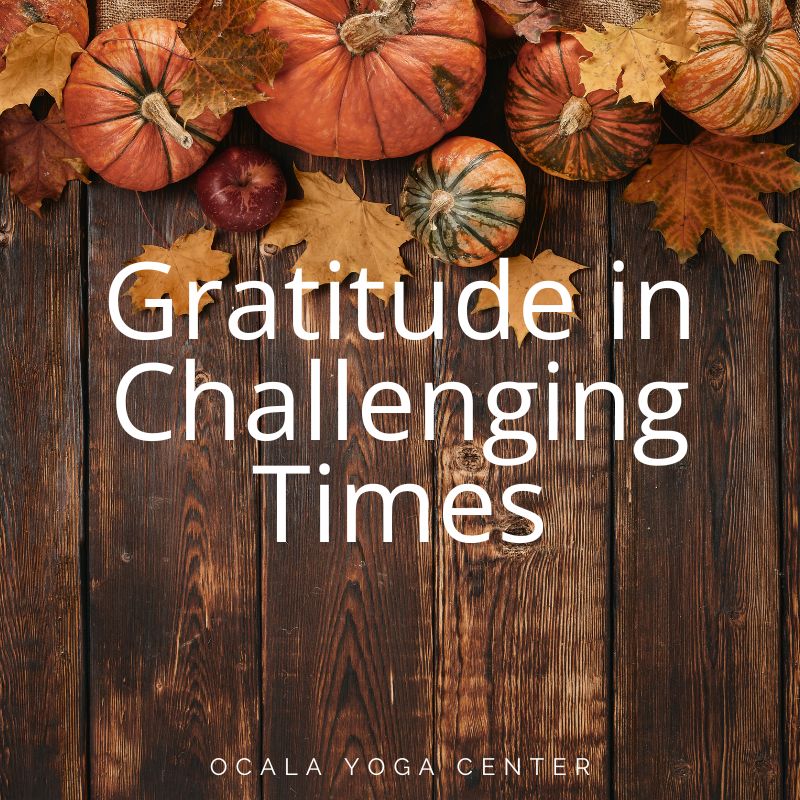Gratitude in Challenging Times
Finding steadiness and grace when the world feels shaky
As we usher in November, it brings with it a familiar theme. No, not pumpkin spice, but rather Gratitude (if you did guess pumpkin spice, that now starts in September). This month especially, we’ll see the topic of gratitude in our social feeds, on coffee mugs, in your inbox, and now in this newsletter. But this year especially, for many of us, those glossy messages on being thankful may feel hollow. Many of us are experiencing our national mood as heavy. Our political landscape is tense, the constant bombardment of alarming news is continuous, and our collective nervous system is tired. Under current circumstances, it’s easy and natural to feel more anxious than appreciative, with the idea of “being grateful” seeming ridiculous and perhaps insulting. And yet, the tradition of yoga is here to remind us that gratitude is not a mood, whether personal or national; it’s a practice.
Sutra II.33: Cultivating the Opposite
One of our greatest yogis, Patanjali, offers this deceptively simple instruction in the Yoga Sutras: “Vitarka badhane pratipaksha bhavanam”, which loosely translates to, “when disturbed by negative thoughts, cultivate their opposites.” In modern terms, it means that when fear or resentment arises, we can consciously choose to pivot toward something positive and life-affirming. Gratitude becomes the antidote, not because it erases fear, but because it transforms our relationship to it. Now, this doesn’t mean bypassing anxiety or pretending everything’s fine; choosing gratitude in challenging times isn’t denial —it’s discernment. Gratitude becomes a grounding practice and a way to stay both awake (yes, woke!) and open to whatever is provoking the fear.
Beyond the Hashtags
In yoga philosophy, santosha, meaning contentment, is one of the five niyamas, the personal observances listed in Ashtanga yoga. This niyama of contentment is not about forced positivity or pretending to love every challenge. Instead, it’s about recognizing sufficiency amid imperfection. This is what makes gratitude more than a seasonal slogan. It’s not a good-vibes-only situation; it’s more like a steady-heart-always outlook on life. To take this point further, it’s about catching yourself in the midst of spiraling, taking a breath, getting grounded, and recognizing something —no matter how minuscule —to be grateful for. Gratitude and contentment are siblings in this sense: both arise when we stop fighting reality and start seeing clearly.
One of my heroes, Brené Brown, writes, “It’s not joy that makes us grateful; it’s gratitude that makes us joyful.” When we practice noticing what’s working, our health, our friendships, the small, ordinary mercies, we create the appropriate conditions for joy to return.
Gratitude is not necessarily about making a list, which indeed can be helpful, but more about awareness. Practicing this awareness can be as simple as taking a conscious breath before reading the latest headline. Other days, it’s recognizing that your mat, your community, and your own willingness to keep showing up are small acts of sanity in a chaotic world.
Another hero of mine, Martha Beck, reminds us that “peace is not the absence of chaos; it’s the presence of clarity.” Gratitude sharpens that clarity. It allows us to see what’s good without denying what’s hard.
Yoga describes this balance in Sutra II.46: Sthira sukham asanam—steadiness and ease. Gratitude lives in that space between the two. It steadies the mind while softening the heart.
The Practice This Season
As we move through November with family gatherings(!), election chatter, and the general swirl of “be thankful” messages, consider treating gratitude less as an obligation and more as an invitation to pause, to take a breath, look around, and notice something pleasant. Maybe it’s a plant, someone’s laughter in the distance, a familiar song coming through the speaker, or one of my favorites: the taste of chocolate!
Gratitude, when practiced sincerely, doesn’t ask us to deny reality. It asks us to stay awake to what’s real and to notice that, even in uncertainty, there is still beauty, connection, and possibility; recognizing that your practice, your community, and your capacity to still care are sacred.
And maybe that’s the most authentic expression of yoga this season: not gratitude as a hashtag, but gratitude as a form of courage; the steady choice to keep the heart open, even when the world feels closed.
Jai Bhagwan,
Kristine

